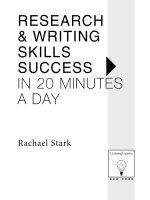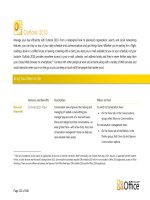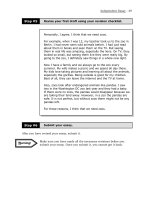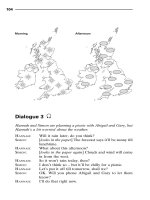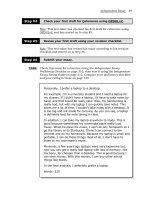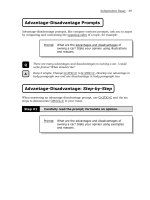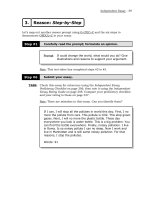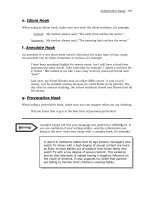Tài liệu RESEARCH AND WRITING SKILLS SUCCESS PART 13 ppt
Bạn đang xem bản rút gọn của tài liệu. Xem và tải ngay bản đầy đủ của tài liệu tại đây (76.61 KB, 7 trang )
Again, remember that being professional
means appealing to the rational and logical
aspects of an argument. When you enter that
courtroom (or present your paper to a reader),
you are walking in with your briefcase in order
and your evidence (or facts) neatly assembled.
You are not breaking down in tears sobbing
before the entire courtroom screaming hyster-
ically, pulling out your hair, and wailing,
“Please, please help my poor client.” Nor are
you handing your reader a blank, scribbled
sheet of paper full of food stains and disorgan-
ized notes.
Logical Appeals In Your Paper
It is hard not to feel passionate about your
subject matter, and feeling passionate about
any topic is a good thing. However, as a writer,
you do not want to rely on your passions or per-
sonal feelings only when trying to convince your
reader. Instead, think of your feelings as a
starting point or a useful tool with which to
construct an airtight argument. Once again,
let’s use the example of the assassination of
President John F. Kennedy. You can write your
thesis statement so that it only appeals to your
reader’s emotions, or you can word your thesis
statement so strongly that it is emotional and
logical. For example, you could write your the-
sis statement this way:
Example A: Please read my paper and I hope
you will believe me when I prove to you that
poor President Kennedy was shamelessly
assassinated by an evil gunman hell-bent on
destruction.
Or, you can word your thesis like this:
Example B: This paper will prove that
Kennedy’s assassination was the willful work
of a lone assailant who meticulously planned
his attack.
Again, both writing samples contain
emotion and conviction, but the second one
conveys emotion through strong word choices.
It does not appeal to the reader’s emotions
only.
Practice Makes Perfect
A simple way to practice making appeals and
to develop the art of persuasion is to practice
out loud with a friend or even to imagine a
scenario with your boss at work. What argu-
ments might you use to persuade your boss to
give you a raise? Emotional arguments might
look something like this:
1. Since you really like me, how about pay-
ing me more money?
2. We’ve been such good friends for the
last few years. In the interest of our spe-
cial friendship, how about promoting
me?
3. If you promote me, I’ll have much more
free time to spend with you and your
family, and we can do things together on
weekends.
Logical appeals to your boss might sound
something like this:
1. The last several projects I completed
were very thorough. Therefore, based on
my past record, I would like the chance
to work on the new account.
– EMOTIONAL VERSUS LOGICAL APPEALS–
71
2. Since I brought in $50,000 dollars in
revenue over the last year, I have demon-
strated my skills as a junior member of
the sales team and would like to try for
the position of senior salesman.
3. Profits, which increased two-fold under
my tenure, would only continue to
increase under my guidance.
Which of these arguments would per-
suade you if you were the boss? Which of the
arguments use facts and evidence as the basis
for their appeal rather than appealing to the
emotions only?
Summary
Passion and emotion are important. You can’t
write or argue convincingly about any topic or
on behalf of anyone unless you have convic-
tion. However, use your passions to build a
solid argument and be sure to provide ample
evidence. If you convey your passion through
logic, you will convince yourself and those
around you. Above all, if your argument is
both logical and full of feeling, you will con-
vince the most difficult of jurors—the reader!
– EMOTIONAL VERSUS LOGICAL APPEALS–
72
LESSON
73
Y
ou may be asking yourself, “What are the differences between facts and opinions?” More
importantly, why does it matter? First, it is important to remember that you are writing an
analytical paper that is a work of nonfiction. Nonfiction is always based upon the stories of people
who have lived or are living, specific data based on proven statistics, and historical events. On the
other hand, fictional material (creative writing of any type) may be based on actual events, but
the author’s imagination takes liberty with the content, shape, or form. Remember that facts are
usually:
1. events known for certain to have occurred, and have been recorded.
2. statistics known for certain to have been proven.
3. people or places known for certain to exist.
Distinguishing
Fact from
Opinion
LESSON SUMMARY
Just as you learned the value of a logical argument supported by
emotional conviction and based upon facts and hard evidence, it
is equally important for you to differentiate fact from opinion,
especially in the books and material that you read. Remember,
your paper will be supported by facts, not opinions. How do you
gather as many facts as possible and learn to distinguish them
from opinions and an author’s personal bias? This chapter will help
you become both a critical reader (as you learn to evaluate your
own sources) and a critical writer (as your influence your reader
and build your case through the steady accumulation of facts).
15
Opinions, on the other hand, are:
1. events believed to have occurred, or
interpreted according to a particular
viewpoint.
2. statistics believed or hoped to be true,
but which have not been unquestionably
and scientifically proven beyond a
doubt.
3. people or places rumored or thought to
have existed.
Learning to Distinguish Bias
One of the problems and uncertainties that
comes with reading many books from a wide
variety of authors is learning to determine
whether someone has presented you with an
indisputable fact, or has just given you his or
her particular take or bias upon events. A bias
is a particular opinion or slant—a judgment
on the part of the writer based upon his or her
own personal viewpoint. When you gather evi-
dence for your paper (which you will later
document for your reader in the form of foot-
notes, endnotes, or parenthetical citations),
always check to make sure that the facts you
are including in your work are legitimate.
Many statistics and data are documented with
a footnote or endnote, indicated by a number
at the end of a particular sentence or quote.
This footnote or endnote informs the reader
that the writer got his or her material from a
legitimate source and a specific location. Some
writers also use parenthetical citations, which
contain the author’s last name, the page num-
ber(s) on which they found the information,
and sometimes the title of the work, if they
have used more than one source by the same
author. The end of the book or article will con-
tain a bibliography or list of works cited,
arranged alphabetically by author. In order to
check a particular fact or quote that the author
has cited parenthetically, simply look for the
author’s name in the bibliography in order to
find the title of the work.
A fact that is not well known, might be
disputed, or is controversial should always be
accompanied by a footnote, endnote, or par-
enthetical citation. Similarly, all statistical
information should also be documented so
that the reader can look up any important
material and verify its accuracy. For example,
an author of a best-selling biography of
President John F. Kennedy might write:
Example A: The day before his assassination,
President Kennedy employed two additional
bodyguards. This fact was kept secret from his
advisors.
1
This statement, complete with a footnote
reference, allows you to check and verify the
sources of this information. Footnotes at the
bottom of the page, or at the end of the book
in the endnotes, allow the reader to check the
source of this fact. The author, following cor-
rect footnote procedure, would have recorded
his or her statistic at the bottom of the page in
the following format:
1
Charles Dobson, My Life with J.F.K.: Con-
fessions of a Former Bodyguard. (New York:
Towson Press, 1998) p. 126.
This footnote should allow you as the
reader to consult that book and find the factu-
– DISTINGUISHING FACT FROM OPINION–
74
– DISTINGUISHING FACT FROM OPINION–
75
al material the author cited. The same format
will be used for endnotes, which appear at the
end of the book or article. It is highly unlikely
that you will check each and every factual or
footnoted statement made by an author, par-
ticularly if you are reading dozens of books.
However, it is very important to make sure
that any information you are using as fact is
backed up by proper documentation. What if
the biography you were reading on JFK pre-
sented the same information in this way:
Example B: There were many rumors that
J.F.K. employed two additional bodyguards
secretly before his assassination, and I’m sure
that he did.
How do you know if this statement is
true? The author does not state it as fact and
does not give the reader any additional sources
to corroborate its accuracy. Did it happen or
not? Is it merely the author’s own personal
opinion or bias? Just as you have learned to
build your argument carefully and support
your conclusions with facts, the same holds
true for the works you are consulting.
Remember, all authors have feelings and opin-
ions, and almost all authors want you to be
persuaded by their work; otherwise, why
would they bother writing books? However,
beware of those writers who try to present
their opinions and biases as facts. If a book or
work does not provide you with specific refer-
ences in order to check the accuracy of its infor-
mation; do not use the material as factual evi-
dence. Writers should try to clarify a reader’s
feelings, not shape or distort them.
Again, think of the task of journalists. A
journalist’s job is to record and present events,
not to offer personal opinions. Opinions in
journalism are reserved for specific pages
only—the Editorial and Op-Ed page. Even on
news shows, TV announcers do not give their
personal opinions unless these segments are
specifically designated as “commentaries.” In
fact, a network or station is quick to make an
announcement that indicates, “The commen-
taries of Mr. Thompson do not necessarily
reflect the views of the network.” For example,
a journalist writing about President Bush and
his actions towards a current or pending piece
of legislation would not say:
Example A: Washington, D.C.—Once again it
was rumored that President Bush is down-
right afraid of signing the Fair Housing Bill.
Clearly, he is too frightened to take any kind
of constructive action.
Instead, a professional reporter would
write:
Example B: Washington, D.C.—Today,
President Bush did not sign the Fair Housing
Bill. While there has been speculation about
his action, White House officials maintain
that he will review the bill later this week.
The first account (Example A) is based on
opinion, hearsay, speculation, bias, and gossip.
These are not legitimate means of gathering,
recording, and presenting material. On the
other hand, the second account presents the
facts and lets the reader draw his or her own
conclusions.
Summary
Distinguishing fact from opinion or fact from
fiction is important. Be alert when you read
and when you write. Is an author convincing
you by using his or her data or is the author
trying to persuade you by manipulating your
opinion? How are you going to convince your
reader? Remember, any statistics or data that
are not supported with specific references can-
not be considered known facts and should not
be used as evidence in your paper.
– DISTINGUISHING FACT FROM OPINION–
76
LESSON
77
I
f you are like most writers, your first draft is almost always a work in progress. This is normal.
Gathering together all your written pages for the first time and looking at them as a finished
product can be nerve wracking but also fun and exciting. It is important, however, especially at
this stage in the writing process, not to be too judgmental or overly critical of either yourself or
your work. You need to remain open-minded and flexible enough to allow your work to take form
without editing it yet. At this initial stage, you should read through your material and ask your-
self the following questions based on this checklist and criteria:
1. LOGIC
■
Does your paper have a recognizable beginning, middle, and end?
■
Have you presented a solid thesis?
■
Have you provided ample evidence to support your thesis?
Revising Your
Draft
LESSON SUMMARY
Now that you have done all the hard work, the rest is relatively
easy. At this point, you should have a solid rough draft in front of
you, and you should be ready to revise. Even if your rough draft
seems to be too rough, and not a finished product yet, don’t
worry! This lesson will help you revise and polish your work and
make it the best piece of writing that it can be.
16
